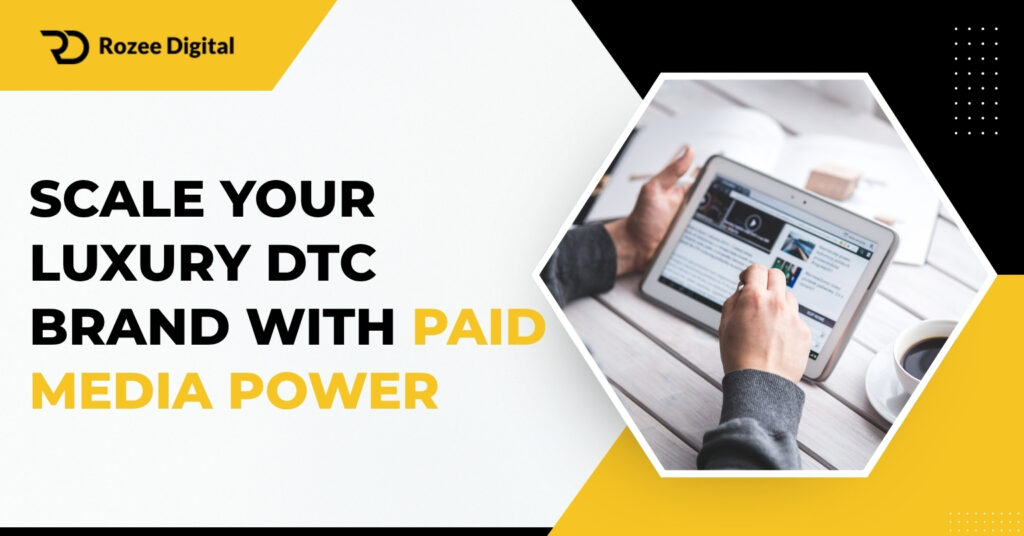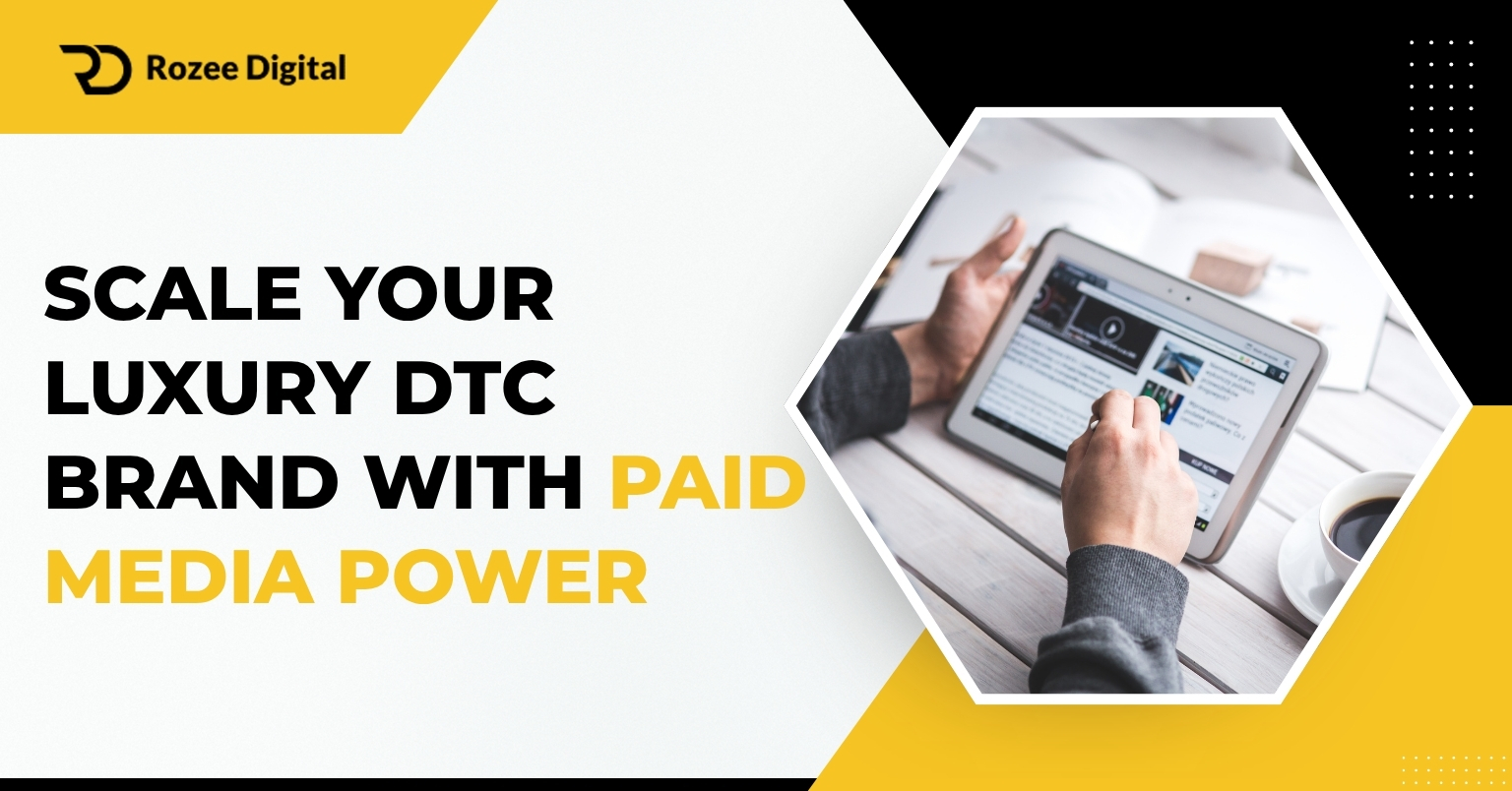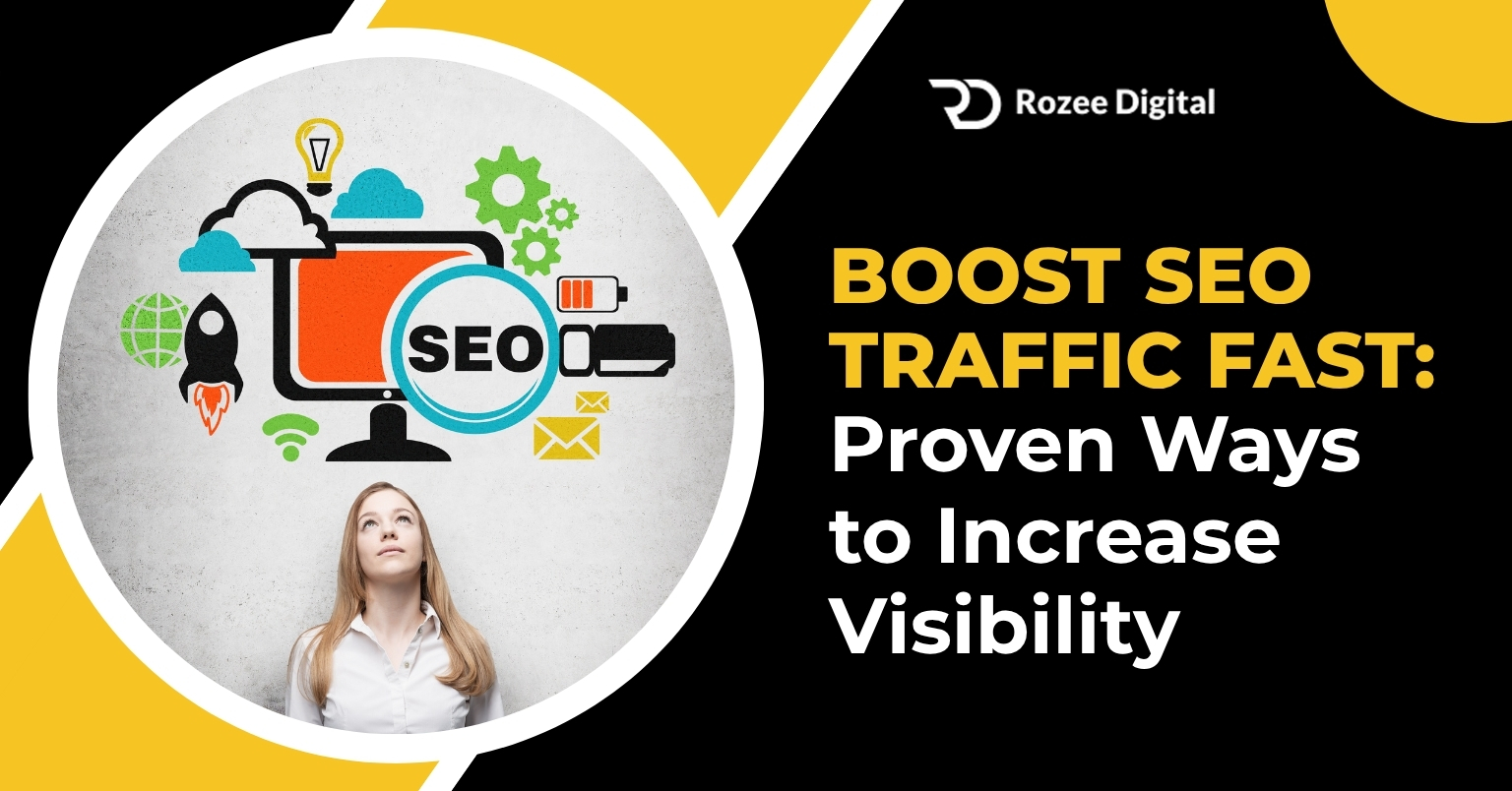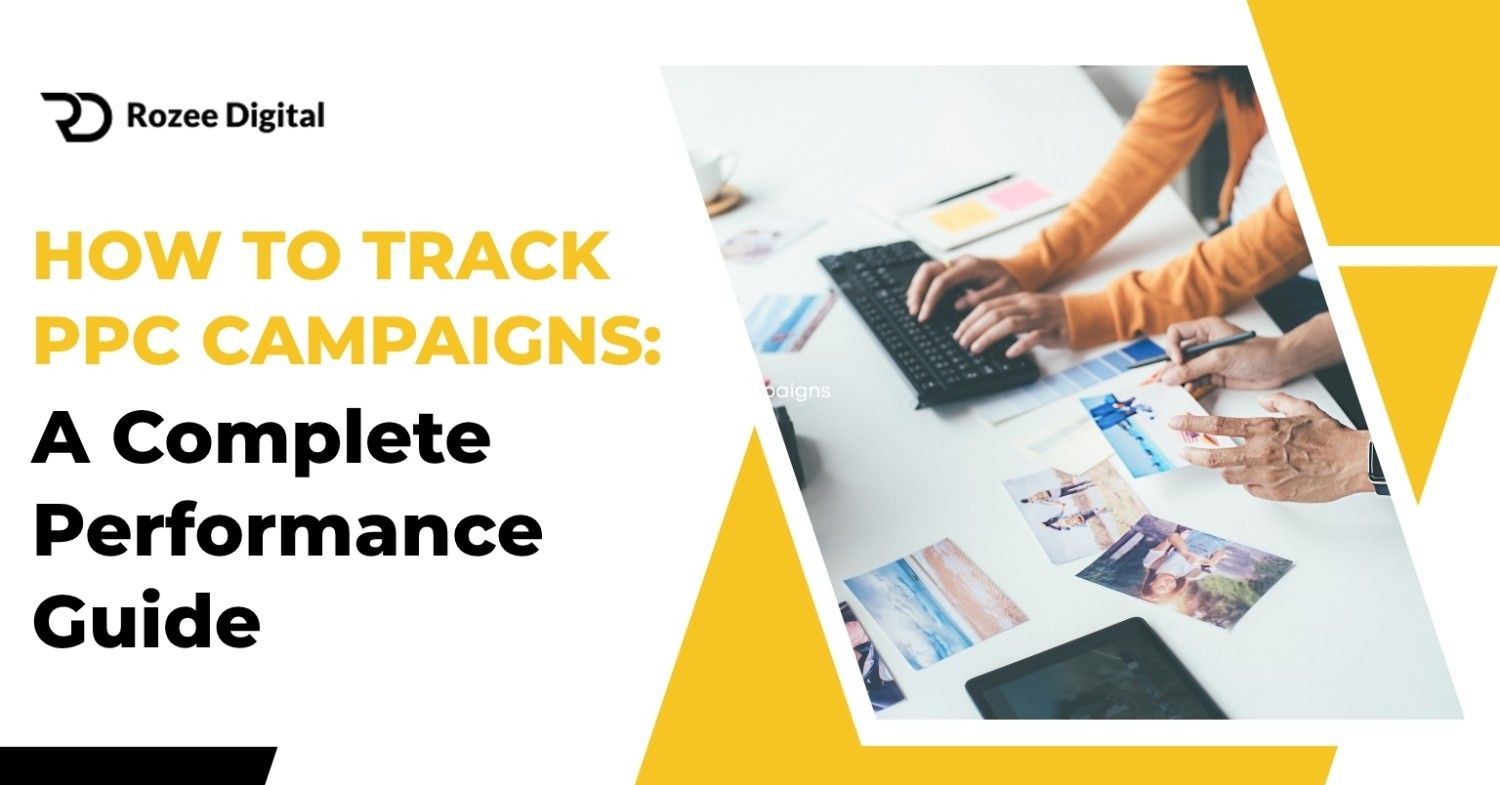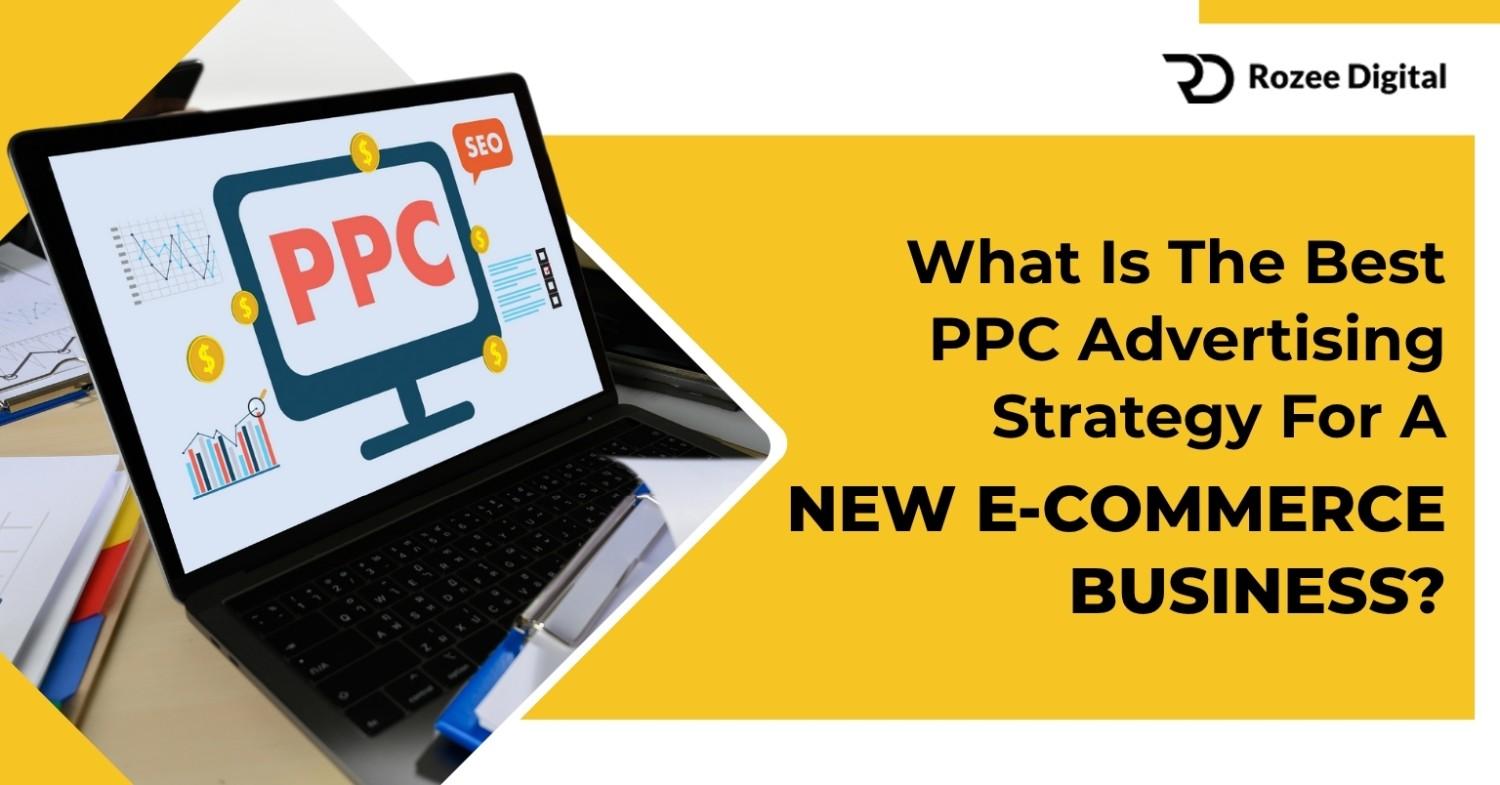The luxury DTC market is growing faster than ever before. According to McKinsey, nearly a fifth of all luxury sales will be online by 2025, reaching around $75 billion. That means digital growth is now one of the biggest opportunities for luxury brands selling directly to customers.
But here’s the challenge. Most luxury brands struggle to scale without diluting their premium image. Traditional advertising feels too cheap. Mass marketing feels wrong. This is exactly where learning how to scale a luxury DTC brand with paid media becomes your secret weapon.
This guide shows you how to grow your luxury brand using smart paid advertising. We’ll cover strategies that maintain exclusivity while driving real growth. No generic tactics. Just proven methods that work for high-end brands.
👉 Ready to scale your luxury DTC brand with precision and exclusivity? Explore our services at Rozee Digital – D2C Ads Agency and book your free strategy call today.
What Makes Luxury DTC Different from Regular Ecommerce
Luxury brands can’t use the same playbook as regular online stores. The rules are completely different. What works for mass market brands actually hurts luxury positioning.
Understanding What is DTC Ecommerce in the Luxury Space
DTC ecommerce means selling directly to customers without middlemen or retailers. You control the entire experience from discovery to delivery. This gives luxury brands power they never had before.
Traditional luxury relied on department stores and boutiques. Brands had no direct customer relationships. They couldn’t control pricing or presentation. DTC changes everything by putting brands in charge.
For luxury specifically, DTC solves a major problem. You maintain complete control over brand perception. Every touchpoint reflects your values. Every interaction reinforces premium positioning. This is impossible when selling through third parties.
The shift to DTC accelerated dramatically during recent years. Bain & Company found that online luxury sales now represent 30% of total luxury purchases. Younger luxury consumers prefer buying directly from brands. They want authentic connections, not department store experiences.
Why Traditional Marketing Fails Luxury Brands
Mass market advertising tactics destroy luxury appeal instantly. Discount codes plastered everywhere cheapen your brand. Aggressive retargeting feels desperate. Constant sale promotions train customers to wait for deals.
Luxury is about exclusivity and aspiration. It’s about feeling special, not finding bargains. When your advertising looks like every other ecommerce brand, you lose what makes you valuable. Premium pricing becomes impossible to justify.
Scarcity and selectivity are core to luxury positioning. If everyone can easily access your products, they’re not luxury anymore. Your paid media strategy must reinforce exclusivity while still driving growth. This balance is tricky but essential.
Think about heritage luxury houses. They rarely advertise sales. They focus on craftsmanship, heritage, and aspiration. Their marketing elevates rather than discounts. This is the model DTC luxury brands must follow while using modern paid media channels.
The Unique Challenges of Scaling Luxury Ecommerce
Growing a luxury brand creates tension between scale and exclusivity. You need more customers to grow revenue. But feeling too accessible damages luxury positioning. This paradox requires careful navigation.
Customer acquisition costs are much higher for luxury. You’re targeting smaller, wealthier audiences. Competition for their attention is fierce. Lower volume means each customer must deliver significant lifetime value to justify acquisition costs.
Luxury customers expect exceptional experiences at every touchpoint. One bad interaction destroys trust built over months. Your website, ads, packaging, and customer service must maintain consistently high standards. This operational excellence costs more than mass market approaches.
Brand dilution is the biggest risk when scaling. Opening too many distribution channels or discounting too frequently permanently damages premium positioning. Recovery takes years or becomes impossible. Learning how to scale a luxury dtc brand with paid media requires protecting brand equity while growing.
The Luxury Consumer Mindset and Purchase Journey
Luxury buyers think differently than regular shoppers. Understanding their psychology is essential for effective paid advertising. Generic conversion tactics won’t work here.
How Affluent Customers Discover and Buy Luxury Products
Wealthy consumers discover luxury brands through curated sources. They trust recommendations from friends, stylists, and exclusive communities. They read niche publications and follow carefully selected influencers. They value insider access and personalized discovery.
The purchase journey is longer and more considered for luxury. Impulse buying is rare at premium price points. Customers research extensively. They want to understand brand heritage, craftsmanship, and materials. They’re investing, not just shopping.
Social proof works differently in luxury. Mass popularity can actually be negative. Limited availability and celebrity endorsements carry weight. Being hard to get increases desirability. Your paid media must create this perception strategically.
Affluent customers expect white-glove service throughout the journey. They want responsive communication. They expect easy returns despite high prices. They value convenience but also appreciate effort that makes them feel special. Your advertising should promise and deliver this exceptional experience.
To refine and test which messages resonate best with your luxury audience, explore our detailed guide on A/B Testing in DTC Advertising. It’s essential for optimizing paid media performance without losing exclusivity.
The Role of Brand Heritage and Storytelling
Luxury purchases are emotional, not functional. People buy feelings, status, and identity. Your advertising must tap into these deeper motivations. Product features matter less than what owning the product says about the buyer.
Brand heritage and craftsmanship stories resonate strongly. How products are made, who makes them, and why they’re special creates value. Luxury customers want to tell these stories when showing purchases to friends. Your paid media should give them compelling narratives.
Exclusivity and insider knowledge drive luxury appeal. Customers want to feel they discovered something special. They value knowing details others don’t. Your advertising can create this by highlighting unique aspects, limited editions, or brand history.
Status signaling remains important but evolved. Loud logos matter less than subtle quality signals. Affluent millennials and Gen Z prefer understated luxury. Your creative should emphasize craftsmanship and taste over obvious branding.
Learn more about building brand identity and exclusivity in our detailed guide on DTC Branding Essentials, a must-read for scaling a luxury DTC brand with paid media effectively.
Trust and Credibility in High Ticket Purchases
Trust is everything when customers spend thousands per purchase. They need absolute confidence in product quality and brand legitimacy. One doubt kills the sale instantly.
Social proof from the right sources builds trust fast. Celebrity customers, influencer partnerships, and press features in luxury publications all work. But the endorsers must match your brand positioning. Mass influencers can actually hurt credibility.
Exceptional product presentation is non-negotiable. Professional photography, detailed product descriptions, and comprehensive sizing information all reduce purchase anxiety. Video content showing products in real settings helps tremendously.
Transparent policies around returns, authenticity, and customer service remove buying obstacles. Luxury customers expect flexibility despite premium prices. Generous return policies signal confidence in your products. This reassurance should be prominent in your advertising and landing pages.
9 Proven Strategies to Scale Your Luxury DTC Brand with Paid Media
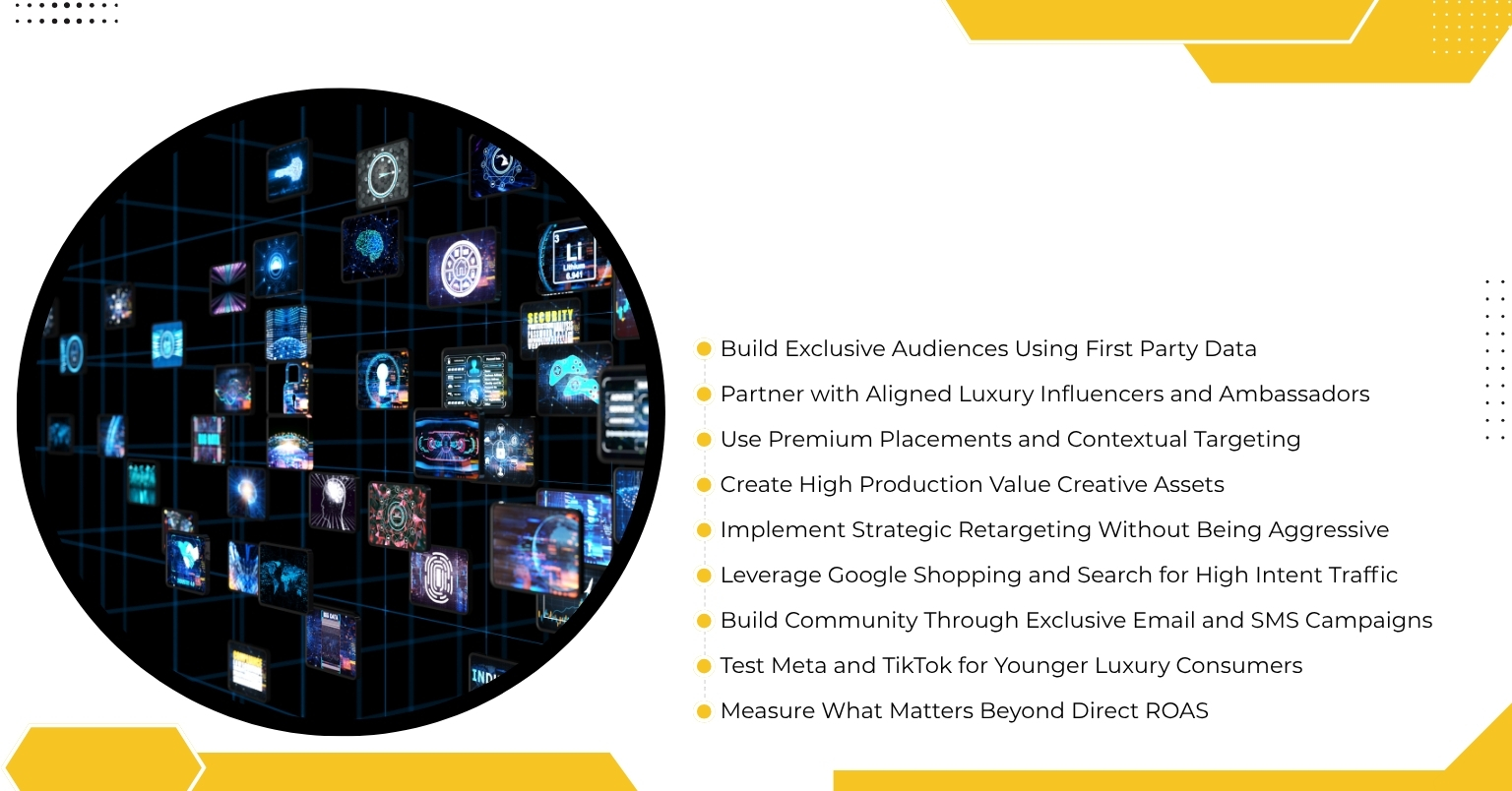
These tactics maintain brand prestige while driving measurable growth. Each strategy works specifically for luxury positioning. Apply them systematically for compounding results.
- Build Exclusive Audiences Using First Party Data
- Partner with Aligned Luxury Influencers and Ambassadors
- Use Premium Placements and Contextual Targeting
- Create High Production Value Creative Assets
- Implement Strategic Retargeting Without Being Aggressive
- Leverage Google Shopping and Search for High Intent Traffic
- Build Community Through Exclusive Email and SMS Campaigns
- Test Meta and TikTok for Younger Luxury Consumers
- Measure What Matters Beyond Direct ROAS
1. Build Exclusive Audiences Using First Party Data
Your existing customer data is pure gold for scaling. These people already trust your brand and understand your value. They’re your foundation for finding more qualified prospects.
Upload customer lists to advertising platforms. Create lookalike audiences modeled after your best customers. Facebook and Google find people with similar demographics, interests, and behaviors. These audiences convert much better than cold targeting.
Segment customers by lifetime value and purchase frequency. Your top twenty percent deserve special treatment. Create VIP campaigns exclusively for high-value customers. Offer early access to new products or private sales. Make them feel recognized and valued.
Track which products customers view but don’t buy. These high-intent prospects are perfect for retargeting. But avoid aggressive frequency. Luxury retargeting should feel like gentle reminders, not desperate pursuit. Show complementary products or styling inspiration instead of just repeating the same ad.
2. Partner with Aligned Luxury Influencers and Ambassadors
Influencer marketing works incredibly well for luxury DTC when done correctly. The key is choosing influencers who genuinely match your brand aesthetic and values. Their audience becomes your audience.
Micro-influencers often outperform celebrities for DTC luxury. They have engaged niche audiences. Their recommendations feel more authentic. And they’re more affordable for brands still scaling. Look for 10,000 to 100,000 followers in your target demographic.
Create long-term ambassador relationships instead of one-off posts. Consistency builds credibility. When customers see the same respected tastemakers wearing your brand repeatedly, it reinforces desirability. Short transactional partnerships feel like ads.
Give influencers creative freedom within brand guidelines. They know what resonates with their audience. Overly controlled content looks fake and performs poorly. Trust them to present your products authentically in their aesthetic. Track performance by unique codes or links.
3. Use Premium Placements and Contextual Targeting
Where your ads appear matters as much as what they say. Luxury brands must be selective about placement. Appearing next to discount brands or low-quality content damages perception.
Use placement exclusions aggressively on display and video campaigns. Block low-quality sites, games, and anything that doesn’t match your brand positioning. Pay more for premium placements if needed. Protecting brand perception justifies higher costs.
Contextual targeting places ads based on page content. Advertise on luxury lifestyle publications, fashion sites, and high-end travel blogs. Your ads appear alongside complementary content. This association elevates brand perception automatically.
YouTube offers premium placement options. TrueView ads on high-quality channels reach affluent audiences in brand-safe environments. Create video content worthy of these placements. Luxury brands need production quality matching their positioning. How to scale a luxury dtc brand with paid media includes investing in premium creative.
4. Create High Production Value Creative Assets
Your ad creative must match your product quality. Cheap-looking ads destroy luxury positioning instantly. Every visual touchpoint should reinforce premium positioning.
Invest in professional photography and videography. Use models that match your target customer aspirations. Show products in enviable settings. Lighting, styling, and composition all matter. This isn’t an area to cut corners.
Video content performs exceptionally well for luxury. Show product details, craftsmanship, and how items look in motion. Behind-the-scenes content about the production process builds value perception. Customer testimonials from recognizable figures add social proof.
Test different creative angles systematically. Heritage and craftsmanship messaging resonates with some segments. Lifestyle and aspiration work for others. Status and exclusivity appeal to different customers. Let data guide your creative strategy while maintaining a consistent brand aesthetic.
For inspiration and real-world examples, explore our curated list of 101 Best DTC Brands’ Facebook Ad Creatives to see what high-performing luxury ad design looks like in action.
5. Implement Strategic Retargeting Without Being Aggressive
Retargeting works but requires restraint for luxury brands. Chasing customers aggressively feels desperate. Strategic gentle reminders work better than constant bombardment.
Set frequency caps limiting how often people see your retargeting ads. Once per day maximum for luxury brands. You want to stay top-of-mind without becoming annoying. Respect their space while remaining present.
Segment retargeting by engagement level and purchase intent. Someone who viewed one product once needs different messaging than someone who spent fifteen minutes exploring multiple items. Tailor ad content and frequency to engagement signals.
Use dynamic retargeting showing products customers actually viewed. But present them in lifestyle contexts rather than just product shots. Show how items complement other pieces. Inspire them rather than just reminding them what they looked at. This approach maintains brand positioning while driving conversions.
6. Leverage Google Shopping and Search for High Intent Traffic
Google Shopping captures customers actively searching for luxury products. This high-intent traffic converts better than cold discovery campaigns. Your product feed optimization determines visibility and performance.
Optimize product titles with specific details luxury customers search for. Include materials, designer names, and style descriptors. “Italian leather crossbody bag” performs better than just “crossbody bag.” Specificity attracts qualified buyers.
Use high-quality images that stand out in Shopping results. Your products appear alongside competitors. Superior photography draws clicks. Show multiple angles and detail shots. Google allows supplementary images now. Use them strategically.
Branded search campaigns protect your brand name. Bid on your brand terms to own that real estate. Competitors may bid on your name. Don’t let them steal customers specifically looking for you. This is defensive but essential for luxury DTC marketing agency clients.
7. Build Community Through Exclusive Email and SMS Campaigns
Email and SMS remain powerful for luxury despite being “old school.” They create direct owned communication channels. You control the message and timing completely.
Segment email lists by purchase history and engagement. VIP customers get different content than first-time browsers. Personalization makes people feel recognized. Generic mass emails don’t work for luxury positioning.
Offer early access to new collections via email. Create FOMO around limited releases. Make subscribers feel like insiders. This exclusivity drives engagement and purchases while reinforcing luxury positioning.
SMS works incredibly well for time-sensitive offers and restock alerts. But use sparingly to avoid annoying customers. Only message when you have something truly valuable to share. Quality over frequency maintains premium perception.
8. Test Meta and TikTok for Younger Luxury Consumers
Instagram and Facebook remain essential for luxury DTC. Visual platforms suit luxury products perfectly. But targeting must be precise to reach affluent audiences and avoid wasting budget.
Use interest and behavior targeting for luxury indicators. Target people interested in luxury fashion, fine dining, premium travel, and high-end hobbies. Layer demographic targeting for income when available. Wealth signals help qualify audiences.
Instagram Stories and Reels drive engagement with younger luxury consumers. Short-form video performs exceptionally well. Show products in aspirational contexts. Behind-the-scenes content humanizes your brand. User-generated content from customers adds authenticity.
TikTok emerged as surprising territory for luxury brands. Younger affluent consumers spend significant time there. The platform favors authentic content over polished ads. Test organic content first, then boost top performers with ad spend. This is part of modern scaling luxury e-commerce strategy.
9. Measure What Matters Beyond Direct ROAS
Traditional ecommerce metrics don’t fully capture luxury brand performance. Customer lifetime value matters more than first purchase ROAS. Brand health indicators predict long-term success.
Track customer lifetime value religiously. Luxury customers should make multiple purchases over time. If LTV isn’t at least 3-4x customer acquisition cost, something’s wrong. Either targeting is off or retention needs work.
Monitor brand search volume and direct traffic. These indicate growing brand awareness and desire. Paid media should increase people actively seeking your brand. This compounds with time as brand equity builds.
Survey customers about brand perception regularly. Do they see you as truly luxury? Would they recommend you? What do they tell friends about your brand? These qualitative insights guide strategy better than pure performance data sometimes.
Platform Selection for Luxury DTC Paid Advertising Tactics
Not all advertising platforms suit luxury brands equally. Choose channels where affluent customers spend time. Match your products and messaging to platform strengths.
Meta Platforms Dominate Visual Luxury Marketing
Instagram and Facebook remain the strongest channels for luxury DTC brands. Visual platforms showcase products beautifully. Precise targeting reaches affluent audiences effectively.
Instagram offers multiple ad formats perfect for luxury. Feed ads, Stories, Reels, and Shopping all work well. Test different formats to see what resonates. Stories feel more personal and immediate. Feed ads allow more detailed storytelling.
Facebook still reaches older, wealthier demographics despite aging perception. Many affluent consumers over 40 use Facebook daily. Don’t ignore this valuable audience segment. They often have more disposable income than younger cohorts.
Advantage+ shopping campaigns use machine learning for automatic optimization. They work well once you have conversion data. But start with manual campaigns for control. Test audiences and creative systematically before letting automation optimize.
Google Search Captures Bottom Funnel Intent
Google search reaches customers actively looking for luxury products. This bottom-funnel traffic converts well. Your investment here directly drives revenue.
Branded search campaigns are non-negotiable. Protect your brand name from competitors. Own all branded search real estate. This defensive strategy prevents losing customers at the final moment.
Generic luxury category terms reach new customers researching options. Bid on “luxury handbags,” “designer watches,” or relevant category terms. Your ads compete for consideration against established luxury houses. Quality Score and ad relevance determine cost efficiency.
Google Shopping works incredibly well for luxury DTC. Product images appear directly in search results. This visual format suits luxury perfectly. Optimize your product feed religiously for maximum visibility. This channel often delivers the best paid media for DTC brands performance.
Emerging Platforms for Next Generation Luxury Consumers
TikTok, Pinterest, and Snapchat reach younger luxury consumers. These platforms require different approaches than Meta or Google. But the audiences are valuable and growing.
TikTok exploded among affluent millennials and Gen Z. Luxury brands that master authentic content win big here. Polished advertising fails. Create content that feels native to the platform. Partner with creators who genuinely love your products.
Pinterest users actively plan purchases and seek inspiration. Luxury fashion, home decor, and jewelry perform exceptionally well. Create stunning Pins showcasing products in aspirational settings. Rich Pins include pricing and availability information.
Snapchat reaches young wealthy consumers, especially in the US. The platform offers advanced AR try-on features for fashion and accessories. These immersive experiences reduce purchase anxiety for luxury products. AR adoption is part of the luxury brand growth strategy moving forward.
Budget Allocation for Maximum Luxury Brand Growth Strategy Impact
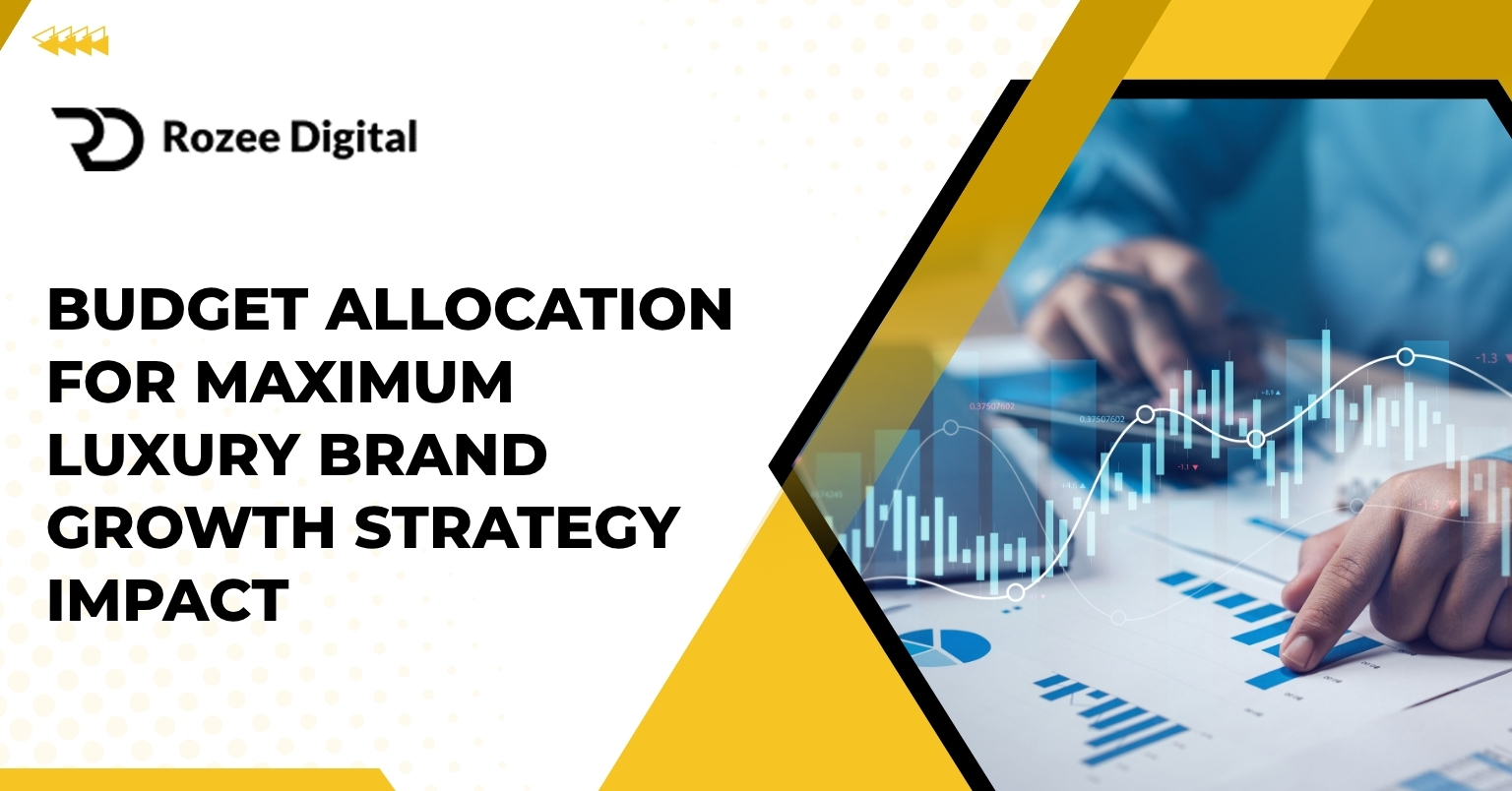
How you distribute the budget across channels determines results. Most luxury brands spread budgets too thin. Concentration creates momentum and learning.
The 70 20 10 Rule for Luxury Paid Media
Allocate seventy percent of budget to proven performers. These channels and campaigns consistently deliver profitable results. Scale what works before experimenting widely.
Reserve twenty percent for testing and optimization. Try new platforms, audiences, and creative approaches. Some tests will fail. That’s expected. Successful tests graduate to the proven seventy percent.
Hold ten percent for opportunistic activities. Limited product drops, seasonal campaigns, or timely cultural moments. This flexibility lets you capitalize on unexpected opportunities without disrupting core strategy.
This framework prevents two common mistakes. Spreading the budget equally across everything teaches you nothing. And putting all budgets in one place leaves you vulnerable to platform changes. Balance concentration with diversification.
Scaling Based on Customer Lifetime Value Not First Purchase ROAS
Luxury brands must think differently about acceptable customer acquisition costs. If the customer lifetime value is $5,000, spending $500 to acquire them is profitable. But only if you think long-term.
Calculate your actual customer lifetime value from past purchase data. Look at repeat purchase rates, average order values, and customer lifespan. This number guides how aggressively you can acquire customers.
Most luxury DTC brands see 40-60% of revenue from repeat purchases. Your first sale might barely cover acquisition cost. But second and third purchases deliver pure profit. Optimize for LTV, not first purchase ROAS.
Set different ROAS targets by campaign stage. Top-funnel awareness campaigns won’t convert immediately. That’s fine. They feed your retargeting audiences. Bottom-funnel campaigns should hit higher ROAS targets. Blended overall performance matters most.
Seasonal Budget Fluctuations for Luxury Commerce
Luxury ecommerce sees dramatic seasonality. Q4 often represents 40% of annual revenue. Budget allocation should reflect these patterns strategically.
Increase budget 30-50% starting in October through December. Holiday gifting drives massive luxury purchases. Capture this demand with an adequate budget. Under-spending during peak season is leaving money on the table.
January and February often see surprising strength in luxury. New year aspirations and winter escape planning drive purchases. Many brands pull back too much after holidays. Maintain presence when competition decreases.
Use slower months for testing and optimization. Try new platforms, audiences, and creative with lower financial risk. Build insights during slow periods that compound during busy seasons. This is how to scale a luxury dtc brand with paid media efficiently.
Measuring Success Beyond Standard Ecommerce Metrics
Traditional metrics don’t tell the full story for luxury brands. Brand health indicators matter as much as direct response metrics. Track both for a complete picture.
Essential KPIs for Luxury DTC Marketing Agency Performance
Revenue from new customers versus repeat customers reveals acquisition and retention health. Aim for 40-60% revenue from repeat purchases. Lower percentages mean retention needs improvement.
Average order value should increase over time as brand equity builds. Customers trading up to higher-priced items indicates successful positioning. Flat or declining AOV signals problems with perceived value.
Customer acquisition cost must stay below lifetime value by a healthy margin. Target 3:1 or better LTV to CAC ratio. This ensures profitability after factoring in operations, product costs, and other expenses.
Brand search volume indicates growing awareness and desire. Track branded searches monthly. Paid campaigns should increase organic brand searches over time. This compounds growth through both paid and organic channels.
Tracking Brand Health Alongside Performance Metrics
Survey customers about brand perception regularly. Use Net Promoter Score to measure recommendation likelihood. Ask about brand associations and competitive comparisons. These insights guide strategic decisions.
Monitor social media sentiment and engagement. What are people saying about your brand? How do they describe it to others? Authentic customer language reveals true positioning. This qualitative data complements quantitative metrics.
Track press mentions and earned media value. Luxury brands benefit enormously from editorial features. Paid media can amplify PR successes. Calculate the equivalent advertising value of earned coverage.
Customer retention rate and repeat purchase timing show relationship strength. Luxury customers should buy multiple times. Decreasing retention or longer purchase cycles indicate problems requiring attention.
Common Mistakes That Kill Luxury Brand Growth
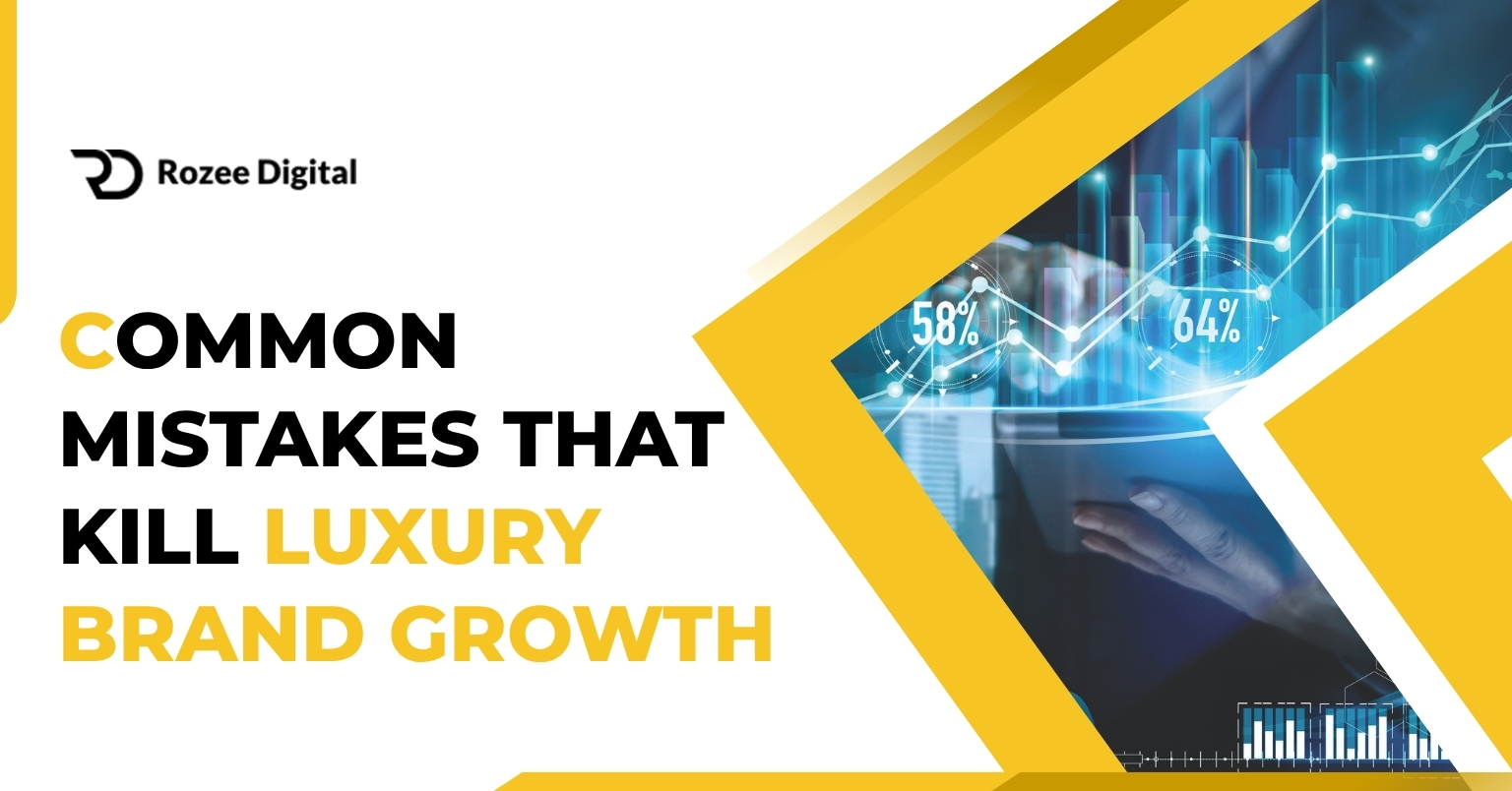
Even experienced luxury brands make critical errors when scaling. Avoiding these mistakes is as important as implementing best practices. Protect your brand while growing.
Discounting Too Frequently Destroys Premium Positioning
Sales and promotions train customers to wait for deals. This completely undermines luxury positioning. Once customers expect discounts, full-price selling becomes nearly impossible.
Reserve promotions for specific situations only. End of season clearance makes sense. Limited-time events for VIP customers work. But constant discounting is fatal for luxury brands.
Use value-adds instead of price cuts when needed. Free shipping, complimentary gift wrapping, or bonus gifts preserve price integrity. Customers get extra value without discounting core products.
If acquisition costs demand promotional offers, provide them privately. Email exclusive offers to targeted segments. Don’t blast discounts publicly. This maintains full-price perception while using promotions strategically for scaling luxury e-commerce.
Mass Market Creative That Cheapens Brand Perception
Using the same playbook as fast fashion or mass market brands destroys luxury positioning. Aggressive CTAs, countdown timers, and loud graphics all feel wrong for luxury.
Your creativity should inspire and elevate, not pressure and promote. Show aspirational lifestyles. Highlight craftsmanship and heritage. Create desire through storytelling. Leave the hard sell to discount brands.
Maintain consistent high production values across all touchpoints. One cheap-looking ad destroys months of brand building. Budget for quality creative. This isn’t optional for luxury positioning.
Test creative variations but keep them within brand guidelines. Data should optimize within your aesthetic, not determine your aesthetic. Maintain creative control while learning what resonates.
Ignoring the Full Customer Journey and Focusing Only on Last Click
Attribution challenges plague all ecommerce but especially luxury. Long consideration periods make last-click attribution dangerously misleading. It under-values top and middle funnel efforts.
Implement multi-touch attribution modeling. Understand how different touchpoints contribute to conversions. Top-funnel awareness campaigns often don’t get the credit they deserve under last-click models.
Track view-through conversions alongside click-through. Many customers see ads without clicking. They search or direct-navigate later. View-through tracking captures this assisted impact.
Maintain investment in brand building even when direct ROAS looks low. These efforts compound over time. Brands that only optimize for immediate ROAS sacrifice long-term growth for short-term efficiency. This is how to scale a luxury DTC brand with paid media wrong.
Real Luxury DTC Success Stories
These examples prove that strategic paid media scales luxury brands profitably. Each followed principles we’ve discussed. Their results show what’s possible with correct execution.
Premium Watch Brand Grows 340% Using Targeted Meta Campaigns
A Swiss-inspired watch brand struggled to scale beyond $2M annual revenue. They relied mainly on organic society. Paid media attempts felt too generic and performed poorly.
They redesigned their entire paid approach around luxury positioning. Professional lifestyle photography replaced product shots. Targeting focused on luxury lifestyle indicators. Creative emphasized heritage and craftsmanship.
They built custom audiences from their customer list. Lookalike audiences found similar affluent consumers. They tested different messaging angles systematically. Heritage storytelling performed best with their target demographic.
Within eighteen months revenue grew to $8.8M. Customer acquisition cost stayed profitable despite premium targeting. Average order value increased twenty percent as brand perception improved. Repeat purchase rate jumped from twenty-five to forty-two percent.
Luxury Skincare Brand Masters Instagram and Influencer Strategy
A clean luxury skincare brand launched with beautiful products but no awareness. They needed paid media to build brand recognition fast. But maintaining ultra-premium positioning was non-negotiable.
They partnered with twenty micro-influencers in the wellness and luxury space. Each created authentic content showing products in daily routines. The brand amplified top-performing creator content with paid promotion.
Instagram became their primary channel. Story ads and Reels showcased product textures and results. They invested heavily in production quality. Every frame looked magazine-worthy.
First year revenue hit $4.2M from just Instagram and influencer partnerships. Customer lifetime value averaged $890. This justified high acquisition costs. Press picked up the brand organically from a strong social presence.
Key Takeaways for Scaling Your Luxury DTC Brand
Scaling luxury brands with paid media requires different thinking than the mass market. Protect brand equity while driving growth. These principles guide successful execution.
Invest in high-quality creative that matches your product positioning. Cheap ads destroy luxury perception instantly. Professional photography and videography are non-negotiable investments.
Target precisely using wealth and lifestyle indicators. Reaching affluent audiences costs more but delivers higher lifetime value. Avoid broad targeting that wastes budget on unqualified traffic.
Build first-party data assets systematically. Customer lists and engagement data power effective lookalike targeting. Your existing customers are templates for finding more qualified prospects.
Measure success by customer lifetime value, not just first purchase ROAS. Luxury customers should buy repeatedly. Optimize for long-term relationships, not transactional one-time sales.
Maintain brand consistency across all touchpoints. Every ad, landing page, and email should reinforce premium positioning. Inconsistency confuses customers and dilutes brand equity.
Ready to scale your luxury brand using proven paid media strategies? Rozee Digital specializes in helping premium DTC brands grow profitably while protecting brand integrity. Our luxury DTC marketing agency approach combines performance marketing with brand building for sustainable growth. Book your free strategy call today or call us today at +447887880993 to discuss how we can elevate your brand with data-driven luxury advertising.
FAQs
Q.1: What is DTC e-commerce and why does it matter for luxury brands?
DTC means selling directly to customers without retailers or middlemen. Luxury brands control pricing, presentation, and customer relationships completely.
Q.2: How much should luxury brands spend on paid media for DTC brands?
Most successful luxury DTC brands invest 25-40% of revenue in paid acquisition. Higher than mass market but necessary for premium positioning and smaller audiences.
Q.3: What platforms work best for scaling luxury e-commerce?
Instagram and Google Shopping deliver best results for most luxury brands. Meta platforms excel for visual storytelling while Google captures high-intent searches.
Q.4: How long does it take to see results from luxury DTC paid advertising tactics?
Most luxury brands see profitable results within 4-6 months. Brand building takes longer but compounds over time with consistent quality execution.
Q.5: What makes a good luxury brand growth strategy different from regular ecommerce?
Luxury prioritizes brand equity and lifetime value over immediate conversion efficiency. Creative quality, selective targeting, and premium positioning matter more than volume.
